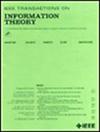Semantic Security With Infinite-Dimensional Quantum Eavesdropping Channel
IF 2.2
3区 计算机科学
Q3 COMPUTER SCIENCE, INFORMATION SYSTEMS
引用次数: 0
Abstract
We propose a new proof method for direct coding theorems for wiretap channels where the eavesdropper has access to a quantum version of the transmitted signal on an infinite-dimensional Hilbert space and the legitimate parties communicate through a classical channel or a classical input, quantum output (cq) channel. The transmitter input can be subject to an additive cost constraint, which specializes to the case of an average energy constraint. This method yields errors that decay exponentially with increasing block lengths. Moreover, it provides a guarantee of a quantum version of semantic security, which is an established concept in classical cryptography and physical layer security. Therefore, it complements existing works which either do not prove the exponential error decay or use weaker notions of security. The main part of this proof method is a direct coding result on channel resolvability which states that there is only a doubly exponentially small probability that a standard random codebook does not solve the channel resolvability problem for the cq channel. Semantic security has strong operational implications meaning essentially that the eavesdropper cannot use its quantum observation to gather any meaningful information about the transmitted signal. We also discuss the connections between semantic security and various other established notions of secrecy.无限维量子窃听信道的语义安全性
我们为窃听信道的直接编码定理提出了一种新的证明方法,在这种信道中,窃听者可以获得无穷维希尔伯特空间上传输信号的量子版本,合法双方通过经典信道或经典输入、量子输出(cq)信道进行通信。发射机输入可能受加法成本约束,这与平均能量约束的情况类似。这种方法产生的误差随着块长度的增加呈指数衰减。此外,它还为量子版语义安全提供了保证,而语义安全是经典密码学和物理层安全的既定概念。因此,它是对现有工作的补充,这些工作要么没有证明指数级误差衰减,要么使用了较弱的安全概念。这种证明方法的主要部分是关于信道可解性的直接编码结果,它指出标准随机码本不解决 cq 信道的信道可解性问题的概率仅为双倍指数小。语义安全具有很强的操作意义,这意味着窃听者无法利用量子观测收集到关于传输信号的任何有意义的信息。我们还讨论了语义安全与其他各种既定保密概念之间的联系。
本文章由计算机程序翻译,如有差异,请以英文原文为准。
求助全文
约1分钟内获得全文
求助全文
来源期刊

IEEE Transactions on Information Theory
工程技术-工程:电子与电气
CiteScore
5.70
自引率
20.00%
发文量
514
审稿时长
12 months
期刊介绍:
The IEEE Transactions on Information Theory is a journal that publishes theoretical and experimental papers concerned with the transmission, processing, and utilization of information. The boundaries of acceptable subject matter are intentionally not sharply delimited. Rather, it is hoped that as the focus of research activity changes, a flexible policy will permit this Transactions to follow suit. Current appropriate topics are best reflected by recent Tables of Contents; they are summarized in the titles of editorial areas that appear on the inside front cover.
 求助内容:
求助内容: 应助结果提醒方式:
应助结果提醒方式:


